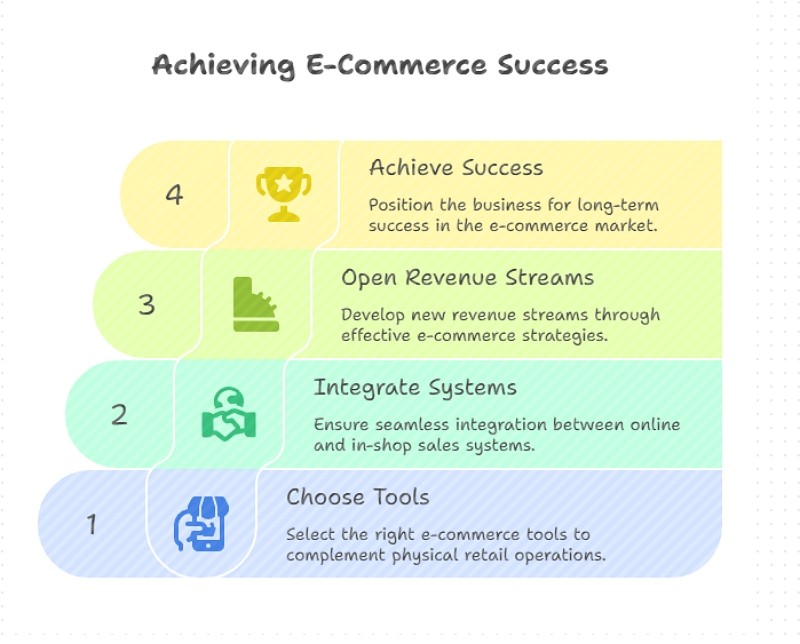
I have had over two decades of experience helping SMB businesses with retail ecommerce in Australia. Over time, I've seen how the correct e-commerce setup can make sales. Here are some key questions that many retailers face.
Firstly, setting up an e-commerce shop involves choosing the right tools that complement your physical retail operations. It's about creating a seamless experience where online and in-shop sales work together. What I suggest is a well-integrated setup that opens new revenue streams. I will try to break it down, highlighting how the right approach can address these pain points and position your business for success.
Key Steps
Define a Niche and your Target Audience
You need to identify products that sell online, considering your customers' demographics.
Choose an E-commerce Platform
Select a tool based on your needs.
Build Your Online Store
It must work for you.
Market Your Products
You need a marketing strategy to reach your customers. What works for SMB retailers is to use their existing customers.
Manage Your Store and Customers
Monitor your performance.
Understanding the E-Commerce Landscape
I believe that in today's retail landscape, e-commerce is vital for remaining competitive. Currently, many Australian retailers are seeing online sales making about 18% of their total revenue, according to recent industry reports. Shoppers now want the convenience of browsing and purchasing at their convenience. For SMB retailers, this creates an opportunity to grow beyond their local foot traffic without the huge upfront costs that expanding their shop space would require.
Do it yourself vs Professional.
Many retailers are drawn to DIY setups because platforms promise simplicity. You log in, pick a template, add products, and launch. It sounds straightforward, especially if you're somewhat tech-savvy. I've never seen owners successfully make a success of such a basic site, but this hands-on method can build your skills and teach you a great deal. If you do it yourself, the time commitment is substantial. Many platforms advertise quick launches. I find that they look cheap, adding custom features on them is difficult, the payment gateways are expensive, and they are generally slow and have limited products. Few people want to spend on such cheap-looking sites. A professional who knows what he is doing typically needs to complete a setup in two weeks to six months. If it's your first time, expect it to take much longer to see any positive results. Your knowledge gaps can compound this. What I found hard at first was tweaking configurations on a host computer; I was unfamiliar with the process and was learning on the fly. Another point often missed is that e-commerce involves proper security setups that are vital to comply with both Australian data privacy laws and to prevent fraud. Overlook these, and you could face bank disputes or legal issues. Developers bring years of experience here; they know many of the pitfalls, and have insurance that might cover you.
Another point is that design talent is significant. Not everyone has that talent. Knowledge is necessary, but it's not enough. A site that turns visitors into buyers needs a layout with appealing visuals.
While you are working it out, it will cost you. People who get to try your site are looking for a professional experience. It's unfair, but they are comparing your site to sites they are used to, such as major sites like Coles, Bunnings, and Amazon. If your site is slow, they will not wait; if it looks amateurish, they will assume your products are too, and they'll move on. Once they move on, they rarely come back.
That said, doing it yourself isn't without merit. You avoid setup fees and gain valuable experience. It would be an ideal experience for your kid who needs internet experience.
Given these hurdles, bringing in experts is the more intelligent choice. Professionals can handle the heavy lifting, delivering a site that's functional, secure, and good from day one. As I stated, if on day one it looks poor, the odds are you have lost them for good. Once your site is up, they will teach you how to use it. You will, however, need ongoing tweaks. This isn't a one-off transaction; it's a partnership that evolves with your needs.
Experts also provide insights into industry trends. They can advise on features. One point is that mobile responsiveness is crucial since over 70% of online shopping in Australia occurs on mobiles. This helps ensure your site gets more traffic.
Once you've chosen professional help, selecting the right platform becomes essential. I'll share my experience with three well-known options I know: WooCommerce, nopCommerce, and Shopify. Each has strengths tailored to different SMB requirements.
ecommerce platform Australia
Choosing a platform is like selecting the foundation for your online shop.
WooCommerce
This is both affordable and flexible, but messy. It is very cost-effective, making it ideal for SMB retailers. It allows you to have a high-quality site without breaking the bank. It starts free, but in practice, you will need extras. The cost of these extras is generally reasonable. What I appreciate is its good SEO. It helps people find your e-commerce site, which is crucial for online businesses. Its customisation is robust. I see the bugs get patched quickly.
However, it does require you to learn a lot. You need to manage as well a WordPress site. From my experience, it's best for retailers who are willing to learn.
nopCommerce
If I had to recommend one platform for most SMBs, it'd be nopCommerce. It's a flagship product with rich built-in features. As of 2025, it's free to use, with community-driven updates keeping it current. It can be adapted extensively without high costs. Well worth it if you ask me, the slightly higher price of WooCommerce.
Shopify
Shopify's popularity stems from its ease of use. You can build a nice-looking site quickly, it's perfect for dipping your toes into e-commerce. It is designed for a small business online shop. Its basic plans start at $39 per month, with higher tiers adding features like advanced reporting. It has a lot of plugins.
On the flip side, it's a more expensive system, with fees that quickly add up.
Many start here and then switch later to something else.
POS Integration
Now, let's talk integration. Without it, you're duplicating efforts; you need to update your stock and sales online, and then in your POS System. Integrating your e-commerce platform with a POS system like ours synchronises everything in real time. Sales data flows seamlessly, updating inventory across channels. For example, imagine a customer buys online from your e-commerce site. With integration, your POS System reflects the sale instantly. It notifies your staff of the details without confusion. New stock comes into the shop; it goes directly into your e-commerce shop.
Your POS System reports work, giving you accurate top-selling products, peak times, and customer behaviours. This drives efficiency gains and strategic advantages, ultimately boosting profits.
Your Next Steps
Ready to transform your retail operations? You can contact me for a chat.
Written by:

Bernard Zimmermann is the founding director of POS Solutions, a leading point-of-sale system company with 45 years of industry experience, now retired and seeking new opportunities. He consults with various organisations, from small businesses to large retailers and government institutions. Bernard is passionate about helping companies optimise their operations through innovative POS technology and enabling seamless customer experiences through effective software solutions.


